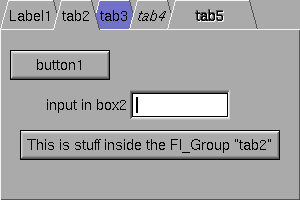
This is the "file card tabs" interface to allow you to put lots and lots of buttons and switches in a panel, as popularized by many toolkits.

Clicking the tab makes a child visible() (by calling show() on it) and all other children are invisible (by calling hide() on them). Usually the children are Fl_Group widgets containing several widgets themselves.
Each child makes a card, and it's label() is printed on the card
tab (including the label font and style). The color of that child is
used to color the card as well. Currently this only draws nicely if
you set box() to
FL_THIN_UP_BOX (this is the default value) or to
FL_FLAT_BOX (which gets rid of the edges drawn on the
sides and bottom).
The size of the "tabs" is controlled by the bounding box of the children (there should be some space between the children and the edge of the Fl_Tabs), and the tabs may be placed "inverted" on the bottom, this is determined by which gap is larger. It is easiest to lay this out in fluid, use the fluid browser to select each child group and resize them until the tabs look the way you want them to.
Fl_Tabs::Fl_Tabs(int x,int y,int w,int h, const char * = 0);
Fl_Widget* Fl_Tabs::value() const;int Fl_Tabs::value(Fl_Widget*);